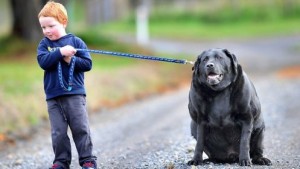Posts Tagged ‘pet cancer’
Pet Obesity Awareness: Tips For Keeping Your Pet Slim & Trim
 Do you know what 88.4 million dogs and cats have in common? They are obese. In a recent study, it was found that 53 percent of adult dogs and 55 percent of adult cats in the United States were classified as being overweight or obese by their veterinarians. Many of these pets were not characterized by their owners as being obese. So in simple terms, fat pets are the new normal in pet ownership.
Do you know what 88.4 million dogs and cats have in common? They are obese. In a recent study, it was found that 53 percent of adult dogs and 55 percent of adult cats in the United States were classified as being overweight or obese by their veterinarians. Many of these pets were not characterized by their owners as being obese. So in simple terms, fat pets are the new normal in pet ownership.
Even though they may be cute, being overweight may be detrimental to your pets health. These extra pounds can put the pets at risk to other disorders such as painful arthritis, heart disease, breathing difficulty, diabetes and even bladder cancer. Obesity not only affects your pets health but also their quality of life.
Certain pets are more likely to be obese. These factors include but are not limited to:
- Breed—Certain breeds such as the Labrador Retriever, Cocker Spaniels and Cavalier King Charles Spaniels tend to more likely affected.
- Age – Older dogs are less active, have less energy, and require less calories.
- Neutering/ spaying – Clinical trials have shown that the basic metabolism is lower in neutered dogs, so they require less calories.
- Medical Problems – Sometimes weight gain can be associated with a medical problem, so a specific treatment may be required.
- Overfeeding – This tends to be the most common problem. Dogs having an unlimited access to food tend to eat more than they need. Also many commercial foods are loaded with salt and fat to improve the taste. This could make your pet want to gorge.
- Feeding habits – Feeding table scraps and “people food” can lead to obesity
- Lack of exercise – As with people, too much food and too little exercise produces a typical result. Obesity
An owner can assess their pets’ weight at home and contact your veterinarian if you think that you have a problem. To do this, I would suggest the following.
- By running your hands along your pet’s ribcage, you should be able to palpate the ribs covered by a thin layer of fat. If you cannot feel the ribs, that could be a sign of an overweight pet.
- Look at your pet from the side. You should see an upward tuck of the abdomen. An overweight pet will have very little to no tuck.
- View your pet from above. There should be a moderate narrowing at the waist just past the ribcage. A straight or bulging line from the ribcage to the hips can indicate and overweight pet.
- A lot of pets will gain weight in the neck area. So if the collar needs loosening, this may indicate obesity.
The most effective way to achieve a healthy weight is to combine increased exercise with changes in your pet’s food or nutrition program. An exercise program should include walking your dog at a constant pace to help burn calories. The program should also include encouraging it to play in the yard or at home. Tossing a frisbee or a ball can also help burn excess calories. It is important to remember that when starting an exercise program, make sure that you ease into exercise. Because an overweight pet is more prone to injury.
A proper diet is essential for your pets overall health and well-being. Balanced nutrition is an important part of an active, healthy lifestyle. A low fat and low calorie diet is essential in helping your pet lose weight and stay fit. Fiber is also an important ingredient since it helps your dog eat less while keeping full. It is important to avoid table scraps and make sure that you account for the treats when considering how much to feed your pet during meals.
Weight loss is important, and your veterinarian is a good place to start. If your pet is obese, a veterinarian can help rule out ailments that can cause obesity and give you advice what foods might be best for your pet. Monitoring its weight loss is also important. A dog should typically lose about 1 pound per month, so monthly weigh-ins will help determine if the program is working for it.
Most things are easier said than done, but that doesn’t always need to be the case. Remember that you are your pet’s will power and are in control of its health. Allowing it to become obese is detrimental, and we know that you don’t want your pet leaving your side any sooner that it needs to. Maintaining a healthy weight is essential to maintaining a long, healthy life. With time and effort on your pet, it will be happier and healthier than ever.
Early Detection Of Pet Cancer
 Did you know that cancer is the number one disease-related killer of pets? Statistics show that one out of four dogs develop cancer while one out of five cats develop some form of cancer. Cancer is a broad term used to describe cells within the body that are growing and dividing in an abnormal manner and rate. These cells divide at uncontrolled rates and ofter form masses or tumors. Some growths can be benign while some may be malignant.
Did you know that cancer is the number one disease-related killer of pets? Statistics show that one out of four dogs develop cancer while one out of five cats develop some form of cancer. Cancer is a broad term used to describe cells within the body that are growing and dividing in an abnormal manner and rate. These cells divide at uncontrolled rates and ofter form masses or tumors. Some growths can be benign while some may be malignant.
Since May has been designated Pet Cancer Awareness Month, I would like to offer some tips to pet owners to aid in early detection and possibly help extend the life of your pet. With regular checkups, early detection and diagnosis can possibly improve the odds of treating the cancer effectively.
Lumps and Bumps: Not all lumps and bumps are cancerous but there is no way to know for sure without getting your veterinarian involved. This is especially true if they are not resolving on their own. A veterinarian may do a needle biopsy and look at the cells in the mass under a microscope. By catching them early, complete removal can be achieved.
Abnormal odors: If you notice abnormal odors from your pets mouth, ears or other parts of their body, I would recommend having it checked out. There could also be a change in your pets food preference like soft or hard or the manner in which it chews. A veterinarian may want to take some radiographs or have a CT scan done to visualize a mass being present.
Abnormal discharge: If you notice blood, pus, vomiting, diarrhea, abdominal distention or bloat on your pet, you may want to get your pet an appointment. Your pets’ abdomen may be distended because of a tumor in the abdomen or it may be distended indicating bleeding in the abdomen. Bleeding from the mouth or other body parts in a young dog usually indicates a bleeding disorder, but in older dogs cancer could be a distinct possibility. Radiographs or an ultrasound could aid in the detection.
Wounds not healing: If your pet has wounds that are not healing, you may want to get your pet examined. This symptom may be a sign of infection, skin disease or cancer. A lot of times, the tumors outgrow their blood supply, so they can become necrotic and have continuous drainage issues.
Weight loss: If your pet has experienced sudden weight loss it is important that this is mentioned to your veterinarian. Sudden weight loss with other clinical signs could be an indication of cancer. If your pet has cancer, proper nutrition is essential for its’ strength.
Appetite change: Pets just don’t stop eating without a cause. This may not be cancer, but it is important to mention to your veterinarian. If your pet has oral tumors, there may be difficulty or pain when chewing or swallowing. If this is occurring, by all means a visit to your veterinarian is important.
Cough and difficulty breathing: This could be a sign of heart disease or lung disease, but this is the most common sign of lung cancer. Some cancer metastasize through the lungs and lead to the symptoms of coughing which consists of a dry, nonproductive cough.
Lethargy/depression: If your pet is sleeping more, less playful, or less willing to go on walks or exercise, this may be a sign of cancer. So do your pet a favor and have him visit your veterinarian.
Changes in bathroom habits: Frequent or straining to urinate or defecate may be a sign of cancer. Also blood in the urine or stool may also be an indication. This may only be a urinary tract infection, but if straining and bleeding cannot be rapidly controlled or recurrent, it may be cancer.
Evidence of pain: Unexplained lameness or pain could possibly be an osteosarcoma, which is bone cancer. If your pet is reluctant to walk, run, or jump, this may be arthritis or joint or muscle disease. But it could also be cancer, especially if it is a large or giant breed. Radiographs can aid in the diagnosis.
Cancer is the number one disease afflicting older pets and early detection is the key to successfully treating your pet. There are several options that await us if it is diagnosed. These may include surgery, chemotherapy, radiation, immunotherapy, targeted therapy, or vaccines.
As always, we appreciate that your pet is part of your family. If you have any questions or concerns, do not hesitate to contact our office.
